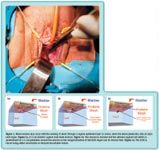Article
Cystocele repair: A simplified, minimally invasive approach
These procedures can be performed with or without concomitant hysterectomy or continence procedures.

Most implement a fabricated, preconfigured soft polypropylene mesh to support the pubocervical fascia of the bladder (central defect) and its torn arcus tendineus fascia pelvis (paravaginal defect). Both conditions are very common and account for a nearly 40% to 50% failure rate in autologous repairs. New, minimally invasive cystocele and paravaginal approaches suspend the bladder from both obturator foramens, recapitulating the Delancey "bladder hammock" level 2 pelvic support.

Polypropylene (Prolene) is a type 1 synthetic material whose weave width can be modified to facilitate bacterial opsonization in the event of infection. Bacteria are 1 mm in diameter, and macrophages are 20 mm. Anterior Prolift (Ethicon/Gynecare, Somerville, NJ) is 75 mm, allowing bacteria harboring in the interstices of infected mesh to be opsonified by macrophages. Meshes (type 3) with 1 mm to 5 mm weaves will not allow macrophage penetration; thus, bacteria may amplify in number.
Once identified, most polypropylene mesh infections can be successfully treated with oral or intravenous broad-spectrum antibiotics, precluding the need for surgical intervention. Type 3 synthetic meshes may require surgical excision, however, because their small weave size prevents macrophage penetration.
Mesh erosion may occur with the simple eroding of mesh through a vaginal epithelial layer (anterior or posterior vaginal wall) or, worse, it may become a complicated erosion when the mesh penetrates into an adjacent organ (eg, bladder, uterus, rectum, or small bowel).

Indications
Surgical correction of prolapse is often indicated by symptom or grade. Overriding symptoms include incomplete emptying of the bladder secondary to urethral kinking, dyspareunia, bleeding from mucosal irritation, or difficulty ambulating.
















